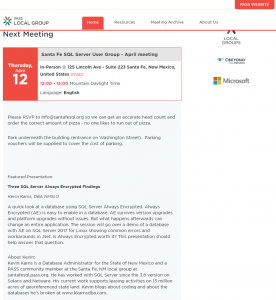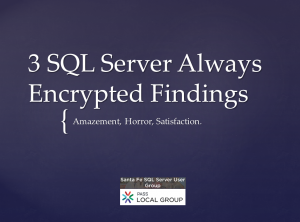On Friday I gave a presentation at the April meeting of the newly created Santa Fe SQL Server User Group santafesql.org.
I was a little nervous since I haven’t given a presentation since a DOE conference in Amarillo, TX in 1991. But in spite of my nerves, it went OK since it was a short 30-minute talk and since we had a great group of attendees. The group was patient with a couple technical difficulties and interacted well when I lost focus doing things like shifting back from slides to demos.
My three findings were amazement, horror, and satisfaction.
The first finding, amazement, was the subject of my last blog post. SQL Server’s ability to flawlessly upgrade an Always Encrypted database over an upgrade and a platform shift to Linux is amazing. I covered it more thoroughly in the blog post than I did in the presentation Taking SQL Server Always Encrypted on a road trip.
I had some pretty serious technical issues in my presentation. Continue reading “Presentation: Three SQL Server Always Encrypted Findings.”



